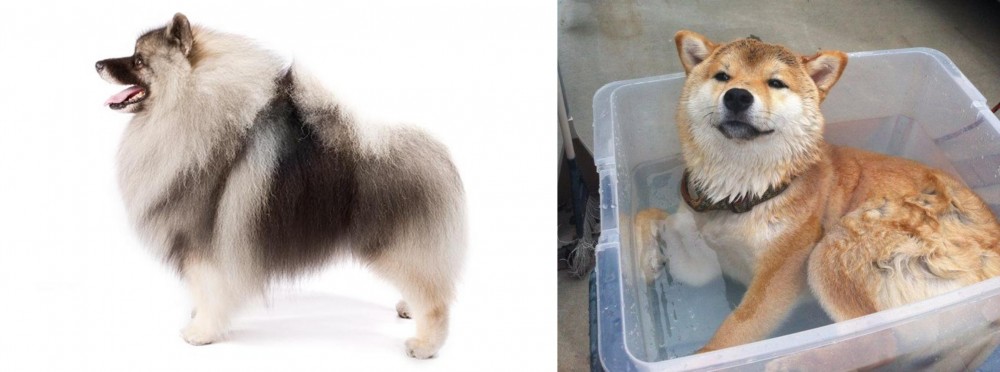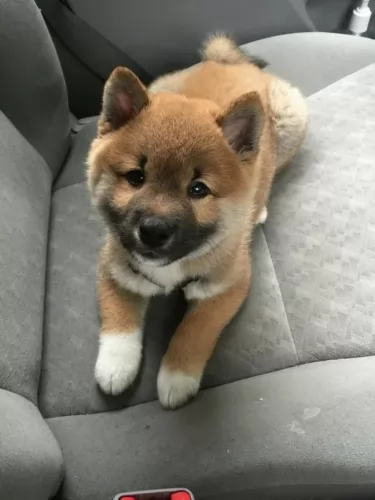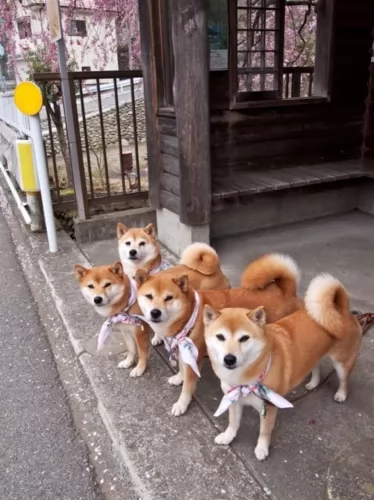 Petzlover
Petzlover Keeshond is originated from Netherlands but Shiba Inu is originated from Japan. Both Keeshond and Shiba Inu are having almost same height. Keeshond may weigh 7 kg / 16 pounds more than Shiba Inu. Both Keeshond and Shiba Inu has almost same life span. Both Keeshond and Shiba Inu has almost same litter size. Keeshond requires Moderate Maintenance. But Shiba Inu requires Low Maintenance
Keeshond is originated from Netherlands but Shiba Inu is originated from Japan. Both Keeshond and Shiba Inu are having almost same height. Keeshond may weigh 7 kg / 16 pounds more than Shiba Inu. Both Keeshond and Shiba Inu has almost same life span. Both Keeshond and Shiba Inu has almost same litter size. Keeshond requires Moderate Maintenance. But Shiba Inu requires Low Maintenance
 Keeshond is the term used for German Spitzes and although many American references have it that the Keeshond originated in the Netherlands, some say the dog originated in Germany and is a member of the German Spitz family.
Keeshond is the term used for German Spitzes and although many American references have it that the Keeshond originated in the Netherlands, some say the dog originated in Germany and is a member of the German Spitz family.
The Club for German Spitzes was founded in 1899. The Nederlandse Keeshond Club was formed in 1924. The Keeshond is also referred to as ‘The Smiling Dutchman’.
It was in the 17th and 18th centuries that the Keeshond was used greatly as a watchdog, appearing in England in the late 1800s, but after the turn of the 20th century, Mrs. Wingfield Digby of Dorset, England and Mrs. Alice Gatacre, a Dutch breed authority, living in England, stirred interest in the breed with their kennels.
An English breed Club was formed in 1926, and the first Keeshond was registered with The American Kennel Club in 1930.
 The Shiba Inu hails from Japan and was a dog bred to hunt birds and small game. The dog is one of 6 native breeds in Japan. Today he is essentially a companion dog in both Japan and the United States.
The Shiba Inu hails from Japan and was a dog bred to hunt birds and small game. The dog is one of 6 native breeds in Japan. Today he is essentially a companion dog in both Japan and the United States.
He is actually one of the smaller spitz dogs in the country but known for his boldness.
The first Shiba Inu was imported into the United States in 1954 and was recognized by their Kennel Club in the Miscellaneous Class and also the Non-Sporting Group.
 The Keeshond is a medium-sized dog and a member of the Spitz group of dogs. He stands at 43 – 48cm in height and weighs 14 – 18kg.
The Keeshond is a medium-sized dog and a member of the Spitz group of dogs. He stands at 43 – 48cm in height and weighs 14 – 18kg.
He has a 2-layered, dense coat which is fairly long, straight and coarse and colors are grey, silver, black and cream. His undercoat is a very light cream color. He has erect ears, a fairly shop muzzle and a feathery, plumed tail which curves over his back.
The hair on his legs is fairly short accompanied with some feathering. A typical marking-feature of the Keeshond is the dark line which runs from the outer corner of each eye to the lower corner of each ear. It's what gives the dog his well known keeshond expression. The eyes of the dog are dark brown.
The Keeshond, just like other Spitz dogs, are playful, affectionate, friendly and eager to please. He is intelligent too and will respond well to training and socialization.
He makes a wonderful family pet as he is friendly and playful with children, loving all their games. He gets on well with other pets too. He is a social dog, thriving on being with his human family, wanting to participate in all family activities.
They are sensitive, loving pets and become very attached to their owners. They have even been used as comfort dogs in rescue situations, as they bond so well with people.
He makes a good watchdog too with his loud bark which he uses to deter intruders. He may well be a good watch- and guard dog but he isn't an aggressive dog.
 The Shiba Inu is a medium sized, athletic dog standing at between 33cm and 43cm in height both male and female and weighing in the region of 6 to 11kg.
The Shiba Inu is a medium sized, athletic dog standing at between 33cm and 43cm in height both male and female and weighing in the region of 6 to 11kg.
He is an agile dog, known for his feline agility. He has the typical spitz dog erect ears and slanted eyes with the tail curling over the back.
The coat is available in a number of colors – cream, red, sesame, black and tan.The double coat is thick and is made up of straight, stiff kind of hair.
This is an intelligent, independent, alert, strong willed dog who has a calm aura about him. He is stubborn too, so it will be best to have him trained or socialized just to make him more amicable to get along with.
As he is a dog that just loves his human family, this training helps him to get along with other dogs too. He is possessive with his human family, wanting to guard them and everything he regards as his territory.
 The Keeshond, with his thick double coat, loves to be outdoors in cool weather. He won't be there too long however, because he will be missing his human family. He is such a social dog, craving human company and therefore isn't a dog to be put out in the backyard and left day after day.
The Keeshond, with his thick double coat, loves to be outdoors in cool weather. He won't be there too long however, because he will be missing his human family. He is such a social dog, craving human company and therefore isn't a dog to be put out in the backyard and left day after day.
He loves games and being totally involved with his human family. Look after your Keeshond well – he is a companion dog - and you will find him to be a most exceptional friend of yours.
 He is the smallest of several spitz dogs that originated in Japan. He is known for his bold, feisty personality and for being so good natured as well. Other excellent characteristics are intelligence, strong-willed, loyal and loving and he has a calm, confident dignity around him.
He is the smallest of several spitz dogs that originated in Japan. He is known for his bold, feisty personality and for being so good natured as well. Other excellent characteristics are intelligence, strong-willed, loyal and loving and he has a calm, confident dignity around him.
He will get on well with kids and other dogs he has grown up with but he can be a bit aggressive towards dogs he doesn’t know.
Always ensure good exercise. Getting outside and active is important for this dog.
You can certainly benefit from having this wonderful dog in your life as he has some excellent characteristics.
 With good food, fresh water, exercise and lots of interaction with your Keeshond, he can reach 12 to 14 years of age.
With good food, fresh water, exercise and lots of interaction with your Keeshond, he can reach 12 to 14 years of age.
No matter how healthy your dog is, he can still get ill, but the chances are less likely when he is feed nutritionally. Nonetheless look out for hip dysplasia, bloat, ear infections, skin rashes and eye diseases.
This is a problem in the lens of the eye. Your dog has a cloudy look to the eye. A cataract can occur when the cells are damaged. A disease such as diabetes can also cause a cataract and high blood sugar levels can change the metabolism of the cells in the lens.
The lens should be crystal clear, but with a cataract, the vision of the dog is obscured. It can cause blindness. Thankfully, cataracts aren't painful and most times dogs with cataracts can still see. There is the option of surgery to remove them too.
 Shiba Inus are generally healthy, but like all breeds, they're prone to certain health conditions. Look out for things such as hip dysplasia, hypothyroidism, bloat, cancer, eye diseases and skin allergies.
Shiba Inus are generally healthy, but like all breeds, they're prone to certain health conditions. Look out for things such as hip dysplasia, hypothyroidism, bloat, cancer, eye diseases and skin allergies.
Skin allergies can come about because of being allergic to food, fleas, too much shampooing and some medications. It can be traumatic for your pet who will sometimes chew and bite to get relief. Treatment varies but get your pet to the vet.
There is pressure in the eye, and symptoms can include vision loss and pain. Glaucoma can be treated with eye drops but sometimes surgery is required.
 With his double coat, your Keeshond will need regular brushing to get rid of all those loose hairs. He is a dog which doesn't have that typical dog odor about him so bathing him is discouraged. Too much bathing irritates a dog's skin and dries it out.
With his double coat, your Keeshond will need regular brushing to get rid of all those loose hairs. He is a dog which doesn't have that typical dog odor about him so bathing him is discouraged. Too much bathing irritates a dog's skin and dries it out.
Check the inside of his mouth and make sure that his teeth are in a healthy state. If you are unsure, speak to your vet about dental hygiene as bad teeth won't only cause pain and discomfort for your pet, the teeth can affect his immune system and other body parts.
Check his claws too and have them cut when they become too long. When they are long they can hook on things and injure the sensitive area of the paws.
The Keeshond is a sturdy dog, loving all the activities and games that his family are involved in. He will love to be your walking companion and looks forward to his walk every day.
He is such a playful, adventurous dog and is always willing to join you in new games. Never put him in your back garden and forget about him, as this will make him ill and depressed. He must be part of the family to be healthy and happy and relies on you to include him in all your activities. He can live in the city or the countryside but will require being exercised wherever he is.
Top quality dry kibble will work for your Keeshond. If you want to keep him bright eyed and bushy tailed, mix in some quality home-made food too such as cooked chicken, rice and vegetables. You can also try to sometimes include a little bit of raw meat as well.
He is an active dog and will need a diet high in protein. Also, his thick coat needs to be maintained, and apart from regular brushing, look for quality dog foods that have Omega-3 fatty acids in them so as to maintain the skin and coat of the dog. Make sure he always has access to fresh, cool water.
 A nice long walk out and about in the neighborhood is good for this dog. Apart from a daily workout, he will love to come running with you or if you go cycling, he will run next to you. He will require exercise every day.
A nice long walk out and about in the neighborhood is good for this dog. Apart from a daily workout, he will love to come running with you or if you go cycling, he will run next to you. He will require exercise every day.
Brushing your Shiba Inu will be required at least twice a week as he is a dog that sheds quite a bit throughout the year. You want to get rid of those loose hairs to keep him looking nice and groomed.
Never pop sugary treats into your pets mouth and avoid feeding him spicy, toxic foods. It can drastically upset his digestion.
You can feed your Shiba Inu commercially manufactured food but it should be the best quality ones. Give him some tasty homemade food too. Simply add into one big pot chicken, brown rice or pasta and spinach, sweet potatoes and carrots. This food can all be chopped up, refrigerated and added warmed up and in small portions to your pets dry kibble once or twice a week.
Try and also give him some raw meat occasionally. Ensure that there is always a bowl of fresh, cool water within his reach.